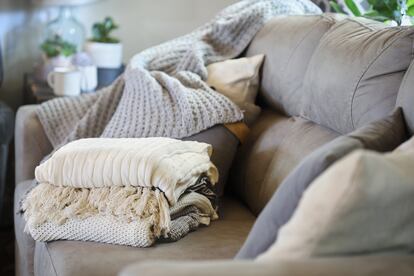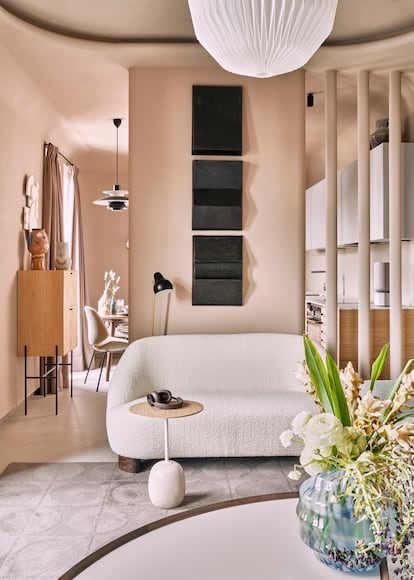Can rugs and curtains help you save energy this winter?
When the cold months arrive, people tend to resort to the usual tricks to keep the house warm. However, while many are useful, it is not always a good idea to fall for the clichés

Designing a “warm” home is a common obsession for decorators and interior designers. But with the uncertainty of the energy bills and the arrival of the colder months, that warmth ceases to be an abstract concept; we actually need our house to be warmer and to remain that way for longer. And even if the obvious course of action would seem to be carrying out a renovation that makes it as energy-efficient as possible, the fastest and cheapest solution could involve little decorative tricks. But how useful is the decoration when preparing the house for winter?
“Finding a house’s cold or humid areas in order to be able to treat them is important, but so is the decoration. It doesn’t only have to be able to retain the temperature; it must also convey a feeling of warmth and make the house cozy,” explains Noé Prades, an interior designer from Barcelona who specializes in designing contemporary atmospheres with artisanal touches. For this purpose, he recommends furniture or surfaces in materials that convey comfort. Some of his favorites are wood – a classic – as well as Mediterranean materials such as clay.
“Ceramics are colder and it’s difficult to heat them, as is the case with natural stones, like marble. It is important to see where they are to use other resources in those spaces,” he points out. To mitigate the effect of cold floors, Prades recommends rugs. “A rug not only fulfills an aesthetic function, but it defines a space, and depending on the type of floor it is necessary to retain the heat and insulate,” he explains. If it is at all possible, he recommends using natural materials and foregoing those of synthetic origin.
According to Joaquín Pérez-Goicoechea from the architecture studio AGi Architects, the choice of materials is crucial in a residential project. He advises against clichés, and instead favoring newer materials such as water-resistant wood or porous ceramics that, unlike the classic ones, transmit heat and can be used for radiant heating.
Pérez-Goicoechea is clear, however, that “it is difficult to achieve energy savings with decoration alone.” Proper insulation is necessary. He knows what he is talking about: his studio has worked on numerous projects in Kuwait, where they must avoid the heat by all means necessary. Along with basic measures such as improving the walls and windows (through which they are able to reduce the energy cost of an entire building by 6% and that of a single home by 80%) they also apply passive strategies like a correct spatial relationship and distribution, taking into account the incidence of the sun. “Passive protections are essential here. I’m talking about traditional exterior blinds, awnings, cantilevers… Elements that help us either open up to the sun or protect us from it, depending on the needs of the season or even the day,” he points out.

What about curtains? Yes, by all means. “They play an important role that contributes to both thermal and acoustic comfort. They are one more layer that, on an already insulated wall, offers greater comfort and warmth,” he explains. Here the fabrics do not have to be natural: when trying to insulate the airflow, almost as a second wall, acrylic may be advisable.
For interior designer Erico Navazo, curtains are also a valid option when it comes to warming a home. He prefers curtains with lining, which are much thicker than the traditional ones and more aesthetic than the artificial ones. “Wool is a great thermal insulator and it also has other functions: it filters the light and creates intimacy,” explains Navazo.
In one of his latest projects, a space for the Casa Decor 2022 exhibition in Madrid, Spain, entitled “Danish Eclectic,” Navazo broke tradition and proved that a warm room does not need rich colors. With the collaboration of the Danish embassy and reinterpreting the classic Nordic style, he designed a kitchen and living room space where the presence of light, thanks to large, unobtrusive windows, was not at odds with a feeling of thermal comfort. In addition, using kitchen furniture made of recycled wood and laminate fronts made from PET bottles, he proved that the choice of furniture not only influences energy consumption: it can also help the planet. “Every choice is important to generate comfort and warmth in a house. But, above all, it is important to have an ecological conscience, not to waste energy, to be sustainable,” he summarizes.
Tu suscripción se está usando en otro dispositivo
¿Quieres añadir otro usuario a tu suscripción?
Si continúas leyendo en este dispositivo, no se podrá leer en el otro.
FlechaTu suscripción se está usando en otro dispositivo y solo puedes acceder a EL PAÍS desde un dispositivo a la vez.
Si quieres compartir tu cuenta, cambia tu suscripción a la modalidad Premium, así podrás añadir otro usuario. Cada uno accederá con su propia cuenta de email, lo que os permitirá personalizar vuestra experiencia en EL PAÍS.
¿Tienes una suscripción de empresa? Accede aquí para contratar más cuentas.
En el caso de no saber quién está usando tu cuenta, te recomendamos cambiar tu contraseña aquí.
Si decides continuar compartiendo tu cuenta, este mensaje se mostrará en tu dispositivo y en el de la otra persona que está usando tu cuenta de forma indefinida, afectando a tu experiencia de lectura. Puedes consultar aquí los términos y condiciones de la suscripción digital.










































